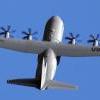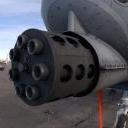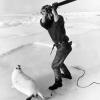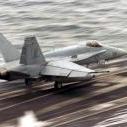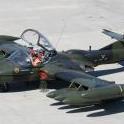Story comes from Elmer Bendiner’s 1980 memoir, The Fall of the Fortresses, based on some light research. Googling the aircraft led to a facebook post about recovering the tail gun that had a comment with the story below about the aircrafts ultimate end it would seem.
The crew of an 8th Air Force B-17 has been recovered from a crash site in the Harwich Estuary.
The wreckage of B17G Flying Fortress 43-37516 'Tondalayo' was recovered from the River Stour by the US Army CHLLI team, led by Major Todd Heussner, and assisted by Royal Navy clearance divers. The sole objective was to recover the remains of the aircraft's missing pilot and co- pilot, Lt Col Earle J. Aber & Lt Maurice J. Harper.
Both men perished on the night of March 4th 1945, when their aircraft was shot down by British anti- aircraft defences .The tragedy unfolded around 9.15pm, when the Tondalayo , returning from a leaflet drop on Amsterdam, Rotterdam and Utrecht, was crossing inland over the east coast. At the same time two enemy aircraft, homeward bound after a sneak raid, were heading easterly at a lower altitude, which no doubt confused the defenders. At 12,000 feet, over Clacton-on-Sea, exploding shells set the aircraft alight in the area of the waist gun positions, severing control cables and injuring the Bombardier, Lt Connie Morton., who sustained injuries to his eyes and right leg. The aircraft rapidly descended to 8,000 feet, and was heading for an emergency landing at Woodbridge when the aircraft was hit again, crippling her further and this time injuring the tail gunner. It was at this point the 'bail out' order was given. All the crew abandoned the aircraft apart from Aber and Harper. Captain Stonerock (navigator) was the last crewman through the hatch at 5,000ft, and later reported that both Aber and Harper had their harnesses on, but not their chutes, so it can only be assumed that they had insufficient time or altitude to do so.
This all matt black special operations aircraft was attached to the 406th Night Leaflet Squadron based at Cheddington, and was the personal aircraft of the unit's commander, Lt Col Aber, being retained by him when the squadron converted to Liberators. Aber was on his 51st mission when he was shot down. Lt Harper had flown Spitfires with the RCAF, before volunteering for a tour on 'Heavies.'
Recovery work began on June 9th 2000, when a salvage barge was positioned on the crash site located on the low tide mark off Wrabness. First attempts at clearing the mud from the site using giant vacuum hoses were soon abandoned due to technical difficulties, primarily with pumps and filters becoming clogged by heavy clay in which the wreckage lay. The recovery continued with a large tracked excavator. The operator worked blindly as the site was only visible for short periods of time. A vast quantity of wreckage was eventually recovered using this method. Parts included one of the aircraft's Cyclone engines together with several super chargers, propeller blades and an undercarriage leg. It was established that the entire tail section and rear fuselage was compressed into little more than eight feet, all of which was painstakingly worked through and sorted until the remains of Lt Col Aber and Lt Harper were found in the area of the bomb bay. Work finally ceased on June 28th when it was thought that sufficient remains of both men had been found. DNA tests later carried out at the US Army Central Identification Laboratory in Hawaii proved their identity. Both men now share a joint grave in Arlington National Cemetery, with Colonel Aber having an additional grave at Cambridge in the American Cemetery.
Pilot Lt. Col E.J Aber
Co-Pilot 2nd Lt M.J Harper
Navigator Capt P.S Stonerock
Bombardier 1st Lt C.R Morton
Radio T/Sgt C.P Valley
Top Turret T/Sgt M.Silber
Ball Turret S/Sgt S.Dombrowski
Tail gunner S/Sgt R.W Ramsey
Waist Gun S/Sgt F.W Thomas
Waist Gun S/Sgt J.A Trexler
Waist Gun 2nd Lt R.W Billings






